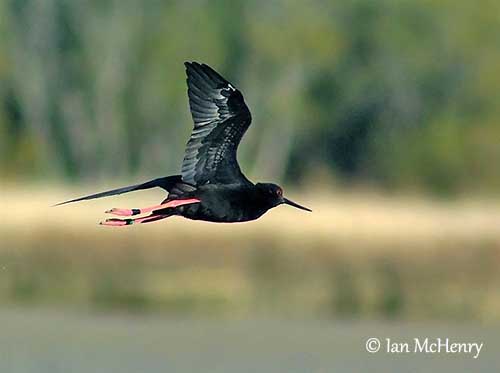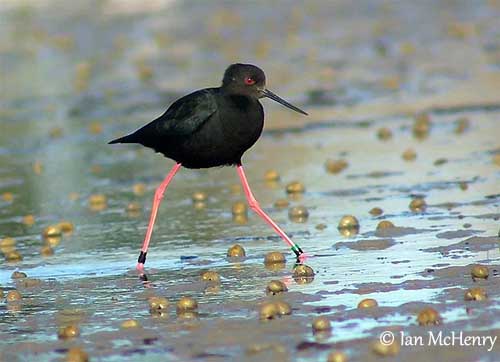
Fr: Echasse noire
Maori: Kakï
Ang: Black Stilt
All: Schwarzer Stelzenläufer
Esp: Cigüeñuela Negra
Ita: Cavaliere nero
Nd: Zwarte Steltkluut
Sd: Svart styltlöpare
Photographer:
Ian McHenry
My New Zealand Birds
Text by Nicole Bouglouan
Sources:
HANDBOOK OF THE BIRDS OF THE WORLD Vol 3 by Josep del Hoyo-Andrew Elliott-Jordi Sargatal - Lynx Edicions - ISBN : 8487334202
SHOREBIRDS by Peter Hayman, John Marchant and Tony Prater – Christopher Helm – 1986 – ISBN: 0747014035
BirdLife International (BirdLife International)
New Zealand bird status between 2008 and 2012
Te Ara – The Encyclopedia of New Zealand
New Zealand birds and birding (Narena Olliver)
Black Stilt
Himantopus novaezelandiae
Charadriiformes Order – Recuvirostridae Family
INTRODUCTION:
The Black Stilt or Kakï in Maori is endemic to New Zealand, but this species is Critically Endangered with a very small population of less than 100 individuals.
Habitat loss and predation by introduced mammals are the main causes of the decline, but in addition, the Black Stilt interbreeds with a recent invader of New Zealand, the Black-winged Stilt (race leucocephalus).
Conservation and captive breeding actions allow release of juvenile and immature birds in the wild, through habitat enhancement programmes in some wetlands and river deltas, and localized predator control.

DESCRIPTION OF THE BIRD:
Biometrics:
Length: 40 cm
Weight: 220 g
The adult has entirely black plumage with green gloss on the upperparts, whereas head and underparts are mostly sooty-black. The birds up to 18 months may have some white flecking on the underparts.
The long, thin bill is black. The eyes are red. Long legs and feet are bright pink.
Both adults are similar.
In non-breeding plumage, we can see some greyish or white feathers on forehead and chin.
The fledging juvenile has white forehead and underparts. Crown, cheeks and hindneck show variable amount of grey. Wings and mantle are greyish-black. Rump and tail are whitish with indistinct broad, greyish terminal band. The bill is dull greyish-pink.
The immature has whitish breast and large black marks on belly and flanks. The hindneck is greyish.
The hybrid bird show more white areas on face and belly than Black Stilt. The adult hybrid has black hindneck, upper mantle and breast band, with variable amount of black on crown, ear-coverts, neck and underparts. But there are some variants.
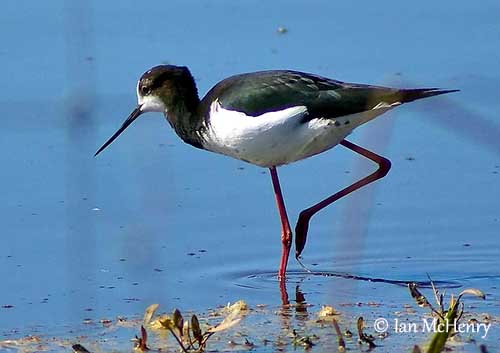
RANGE:
The Black Stilt was formerly widespread throughout New Zealand in the late 19th century. Following a long-term decline, the species is now restricted to the area between Lake Tekapo and Lake Pukaki basins, N to the Ahuriri River on South Island.
Outside the breeding season, they move locally within the Mackenzie Basin, and small numbers may winter on the Canterbury coast on South Island.
HABITAT:
The Black Stilt breeds on braided riverbeds and associated marshlands including swamps, ponds and shallow water at lake’s edges. The nesting site is often established in areas with abundant food sources.
However, these areas are vulnerable to flooding and accessible to predators because the nests are on dry ground.
After breeding, they move to the coast but they forage in river deltas and parts of river which do not freeze over.
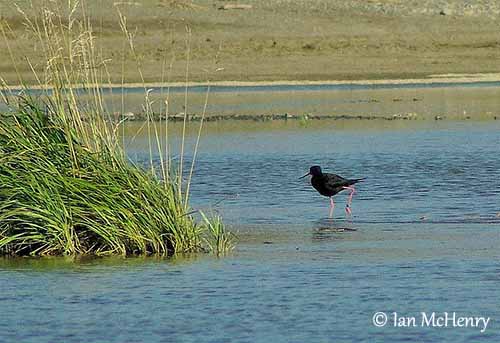
CALLS AND SONGS: SOUNDS BY XENO-CANTO
The Black Stilt gives more penetrating and higher-pitched yapping calls than those of the Black-winged Stilt (race leucocephalus). They communicate by a single “yep” but sometimes, this call can be repeated.
BEHAVIOUR IN THE WILD:
The Black Stilt’s feeding technique is slightly different from that of other waders. It can feed by probing in river shingle, but also by scything motion, moving the bill back and forth, and by pecking in muddy pools. The long bill allows the bird to extract preys beneath stones in riverbeds.
The Black Stilt feeds on a variety of preys such as fish, molluscs, crustaceans and aquatic worms. Inland, it takes mainly insect larvae, earth worms and some spiders, usually found in the soft substrates of the fields.
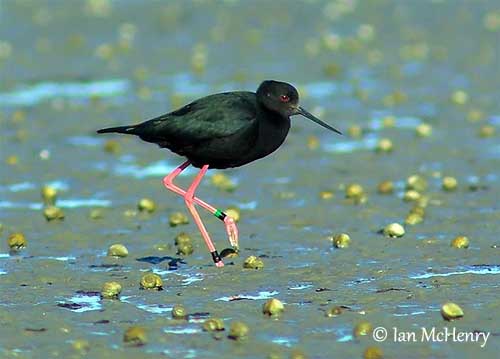
This species is monogamous and the pair has long-term pair-bonds. This species tends to nest in solitary pairs.
The mates perform preening and bill-dipping prior to copulation. The bird inclines the head forwards with stiff neck. They raise their bills out of the water, and then immerse them to eye-level. The movements are synchronized between both mates.
After mating, the birds cross their bills and walk forwards together. The head is raised and usually, the male puts one wing over the back of the female.
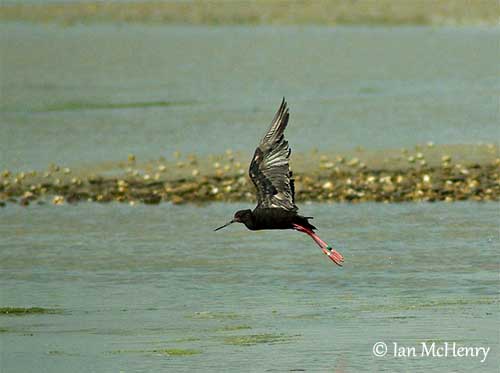
In New Zealand, the Black Stilt interbreeds with the Black-winged Stilt (race leucocephalus) and offspring are fertile. As the species is scarce, there is unusual bond formation and hybrid pairing or trios.
The pair defends the territory and can become aggressive against intruders. They attack and mob aerial predators and some distraction-displays can be used on the ground directly towards the predator. “Broken-wing display” and “false brooding” are used. In the latter, the bird can be seen incubating on a false nest in full view of a predator, while the cryptic eggs or chicks remain invisible in the real nest.
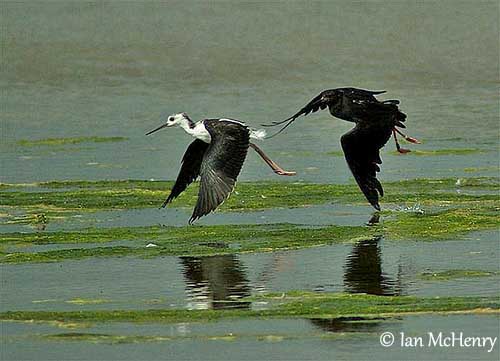
The Black Stilt performs short movements after the breeding season to different habitats within the same river systems. It is known to be mainly sedentary.
However, the pairs Black Stilt / Black-winged Stilt (race leucocephalus) and the hybrid birds usually migrate to Northern New Zealand.
Stilts have fast, direct flight with steady wingbeats.
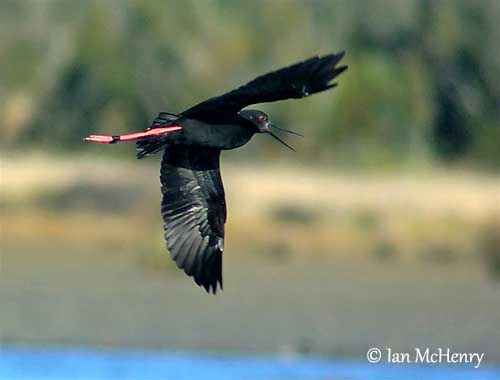
REPRODUCTION OF THIS SPECIES:
The breeding season occurs between September and January.
The Black Stilt nests in solitary pairs in braided rivers on banks near water, streams or swamps. They arrive on their breeding areas in July and establish the territory. The nest is a depression placed in clumps of grass and made with twigs, grass and waterweeds, and it is lined with vegetation.
The female lays 4-6 pale olive eggs with dark markings, a very cryptic colour. Both adults share the incubation during 25 days, with stints of about one hour. At hatching, the chicks have cryptic-coloured down, pale brown above with blackish spots, and white below. They are precocial and leave the nest very soon after hatching. They are still guarded by at least one parent, but they quickly become expert hunters. They fledge about 4-8 weeks after hatching. They can breed at 2-3 years old.
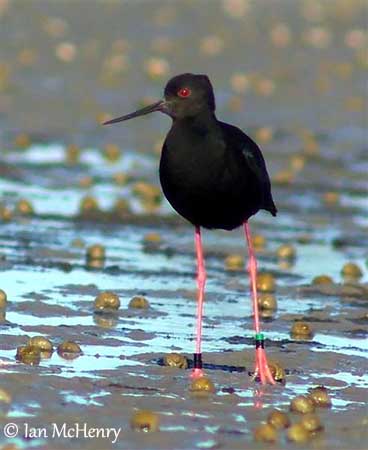
PROTECTION / THREATS / STATUS:
The Black Stilt is threatened by introduced cats and ferrets, habitat loss and human disturbance at breeding sites.
Captive breeding in Mackenzie Basin by Department of Conservation is an important part of the recovery programme. The chicks are raised in captivity and released into the wild at two months and nine months, at two different ages of their growth. The captivity protects eggs and chicks from predation when they are most vulnerable.
By 2005, the population was estimated at 55 adults with 11 pairs. By 2007/2008, some increase occurred with 93 individuals.
The Black Stilt is one of the most threatened shorebird in the world, and hybridization with Black-winged Stilt (race leucocephalus) and resulting hybrids complicates the recovery process.
The species is currently classified as Critically Endangered.
